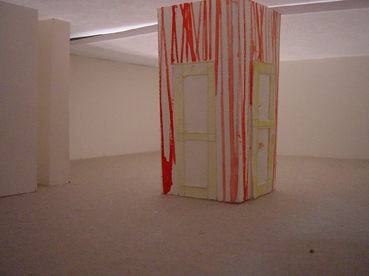Gesellschafts- und Wirtschaftsmuseum, Berlin
Museum for Society and Economy, Berlin, Episode 1
Monument for Schröderstrasse
Schröderstrasse was one of the spaces in the dilapidated eastern parts of Berlin of the 90s. The population having fled fearing to be trapped in the wrong part again, the administration didn’t want to hand the empty city over to the local population but rented the spaces cheaply to whoever appeared to be something like an artist.
The colourful outside of the monument reminds the wallpainting of Jazzclub Berlin, the bar organised by the people who had rented Schröderstrasse. The original name was an attempt to corrupt the early image of Berlin, as presented e.g. at the Venice Biennial in 1996, naming the Berlin art presentation Club Berlin, thus trying to establish Berlin as the new hip art centre.
While the monument turns the inside of Schröderstrasse into the outside, it indicates that Schröderstrasse as a self organised space could include whatever was outside which shows that wherever you are, you are in the environment created by Schröderstrasse, meanwhile there are four doors to possibly exit Schröderstrasse which will inevitable lead you into the museum. The doors being placed in all directions give you the possibility to enter the museum even without being seen by others, given the presumption that whenever you have entered the public would for the play’s sake pretend they wouldn’t know that you and how many other people were already inside.
The inside is a cheap copy of the environment we are in at the moment, enhancing the neutral and empty space of the museum and showing exactly the environment artistic practices like Schröderstrasse are exhibited again.
The monument for Schröderstrasse refers to a place that couldn’t exist in Berlin anymore, in fact the place now occupying the space is a posh architects office. The city once rotten and empty is now cheaply renovated and while still being fairly empty pretends to be flourishing and functioning.
But people in Berlin didn’t stop to open and close spaces. The most important detail on this practice is the financial concept that consists of illegally selling beer to the population. This leads to the fact that the empty beer crate is the most popular element in every artist run space in Berlin, depicting the financial reality of self organisation.
Schröderstrasse was done by the artists Martin Ebner, Katja Eydel, Christoph Keller, Ariane Müller, Katja Reichard, Nico Siepen, Klaus Weber and Amelie Wulffen.


